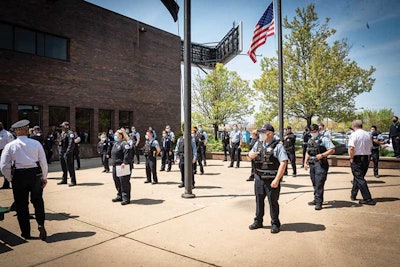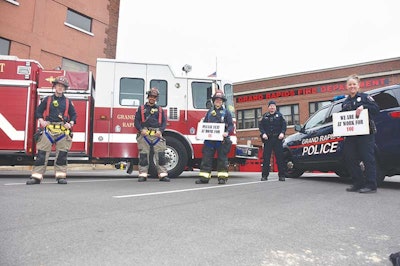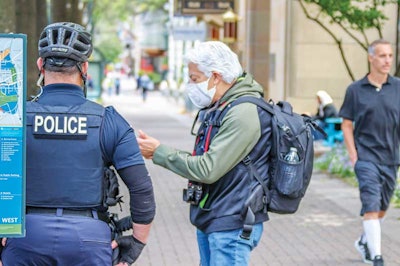 During the COVID-19 pandemic the Chicago Police Department held some of its daily briefings outside.Photo: Chicago PD
During the COVID-19 pandemic the Chicago Police Department held some of its daily briefings outside.Photo: Chicago PD
Since the end of March most of the law enforcement agencies in the United States have been presented with massive challenges. The coronavirus pandemic has forced them to develop way to continue providing services while not unnecessarily endangering their personnel or the public. Technology has played a major role in this effort.
The technological infrastructure that has been built by many law enforcement agencies has been critical to their pandemic response. These tools have given officers the capabilities to perform their duties while maintaining coronavirus social distancing precautions with fellow officers and with the public.
Sending People Home
One of the first steps taken by many businesses to guard their employees from the coronavirus was to close their offices. Those companies that could empty out the cubicles and maintain operations did so by telling workers to literally go home and work, either on company-supplied equipment or on their own personally owned computers and phones.
The same actions were taken by numerous law enforcement agencies. Non-sworn personnel, who on many agencies make up more than half of the labor force were moved to home offices, where possible.
Of course the nature of law enforcement and the sensitive data involved made this move more complicated than it was for most private companies. A police department or sheriff’s office couldn’t just tell a civilian employee to use their own personal computer. Agency computers with the proper security requirements had to go home with the employees.
Most agencies chose to send their non-sworn personnel home with laptop computers. But there were concerns about having enough laptops to go around. Sabih Khan, the Chicago Police Department’s deputy chief of technology and services says there just were not enough laptops to go around at the beginning of the crisis because of funding issues but such budget concerns waned in the face of the pandemic. “Before this we had struggled with trying to get more and more laptops. But due to this situation, we just had to go ahead and make those purchases. We bought a lot more hardware for the capability of remote meetings and remote working for a lot of our civilian staff,” he says.
The Charlotte-Mecklenburg Police Department did not face the same issues with laptops as Chicago. “We were able to scrounge up enough laptops,” says Deputy Chief Jeff Estes. The Grand Rapids (MI) Police Department also didn’t have issues with supplying its work-from-home personnel with laptops. Captain David Schnurstein, head of the Grand Rapids PD’s communications, records, and technology department says a contract the agency signed with its vendor to supply replacement laptops for aging systems in the agency’s patrol vehicles was beneficial during the coronavirus crisis. Grand Rapids PD was allowed to keep the older laptops, and during the pandemic, those aging machines were sent home with remote workers.
Some of the remote workers from the Grand Rapids PD were actually sworn personnel. Schnurstein says the detective unit was sent home. “We had a strategy of you do not have to be here in your offices,” he says. “Detectives can do the job from their cars.”
Working Remotely
Sending people home and providing them with laptops are just the first steps. The laptops are useless without software, networking, and the tools for video conferencing.
Since the crisis began, the number one piece of business software used worldwide has been video conferencing tools. And because of known security issues with some other video conferencing tools and because so many businesses are running Microsoft Office 365, the primary video conferencing tool used in the private sector has been Microsoft Teams. It’s also really popular with law enforcement.
All of the sources contacted for this article said their agencies are using Teams for a variety of operations. Chicago, however, faced a major challenge using the streaming meeting platform. Many Sworn officers working in the divisions use desktop computers, and those desktop systems did not have built-in microphones or cameras for video conferencing. “We had to order them,” Khan says. Now the Chicago PD is a Teams power user. “We had a recent large promotion of sergeants and lieutenants and their training was on Teams remotely streaming on laptops,” Khan says.
Another piece of technology that was critical for many law enforcement agencies as the pandemic sent personnel home was virtual private network (VPN) systems. Grand Rapids PD was fortunate, it already had a secure NetMotion Wireless VPN in operation. “It’s on all the time and you can’t access the network without it,” says Schnurstein. “To the user there is nothing different that they have to do. So we could say here you go, be gone. That was only possible because we had the network.” Estes says Charlotte also had adequate VPN capability for the remote workers.
In contrast, there were “growing pains” setting up VPNs in Chicago, according to Khan. The agency used a third-party vendor to set them up and it was overwhelmed with demand. With the number of employees needing the service, it could take a week to get them up and running. Khan says it now takes a day to do the same job.
Officer Distancing Tools
Since the pandemic struck the U.S. in March, POLICE has conducted multiple surveys on how law enforcement agencies are protecting their officers. One of the most common ways is through the virtual roll call. Standard shift briefings are not being held at most agencies.
“We eliminated in-person briefings,” says Grand Rapids’ Schnurstein. “We’ve replaced them with a very long e-mail.” Daily command staff briefings are being held virtually on Teams, he adds.
Charlotte has also eliminated roll calls. “We will only come in contact with each other when necessary,” Deputy Chief Estes says. Most of the Charlotte-Mecklenburg PD’s patrol officers report for duty in the parking lots of their division stations. They are met by sergeants who give them the keys to their squads and their assignments for the day. The department is also using virtual roll calls for some units.
In contrast, Chicago has continued roll calls with some social distancing twists. “Roll calls have been moved out of the roll call rooms or staggered where there are no more than 10 officers in a room or they are being held outside or in larger areas but they are being maintained,” Deputy Chief Khan says.
Training is another area in which agencies are social distancing or using technology to prevent exposing officers to the virus. Chicago is relying on e-learning technology to disseminate new policies and procedures. The agency also has an intranet called The Wire that is used for superintendent announcements and other videos.
Estes says the Charlotte-Mecklenburg PD was also in a solid position to continue in-service training during the pandemic. “We already do a lot of our training online. We use training software to put it on officer’s learning plans,” he explains.
Officer Safety
From the answers agency brass has provided to POLICE in surveys about how they are protecting their officers, one of the most popular officer protection measures is staggered scheduling. Chicago staggered hours for non-sworn staff not working from home such as forensics specialists and for its sworn officers. Charlotte-Mecklenburg used analytics to determine how many officers were needed to do the job, given the lockdown conditions in the city and county.
 The Grand Rapids Police Department department sent most of its non-sworn personnel home and put patrol officers on a seven-days-on, 14-days-off schedule. Photo: Grand Rapids PD
The Grand Rapids Police Department department sent most of its non-sworn personnel home and put patrol officers on a seven-days-on, 14-days-off schedule. Photo: Grand Rapids PD
Grand Rapids took a very unusual approach to scheduling, according to Schnurstein. Officers were moved to a seven-days-on-14-days-off rotation. That scheduling required officers to work seven 12-hour shifts in a row, but it also meant they were off duty during the known 14-day incubation period of the virus.
Grand Rapids officers were also sent home with their cars. The officers were encouraged to decontaminate their own cars during their seven-day shifts, and they were professionally decontaminated before hand over to the next shift or if a suspected exposure occurred.
Grand Rapids has greatly minimized the number of officers who come to the station. Officers don’t even have to return to the station for video upload or camera exchange. The Axon in-car and body cameras the agency uses download their data into its internal cloud via LTE cellular. “There isn’t a reason that people keep having to come back to the building,” says Schnurstein.
All of these measures appeared to have worked for the Grand Rapids PD. As of early May, only one employee of the agency had tested positive for the virus and none had contracted the disease.
In addition to scheduling, one of the ways that agencies have worked to protect their officers is by providing personal protective equipment (PPE). Finding sources of PPE was not easy for a lot of agencies, but the Charlotte-Mecklenburg PD was in an enviable position with PPE because of contingency planning and officer safety concerns that rose up before the plague. “For the last 20 years or so, we have been very thoughtful about PPE,” says Estes, praising the agency’s logistics and special operations staff. “We had a good supply of N95 masks from fentanyl protection kits and H1N1 protection kits. Before COVID-19, every officer had been issued a fentanyl kit, which contains N95 masks, gowns, and gloves.” In addition to the N95 masks, Charlotte-Mecklenburg officers have been provided with fabric masks for everyday use.
Maintaining Operations
The leaders of the agencies contacted for this article realized as the pandemic reached the United States that they were going to need to find ways to maintain operations and serve their communities while protecting their officers and protecting the public.
In order to protect officers, many agencies chose to reduce officer interaction with the public. Traffic stops were reduced; property crime victims were encouraged to make reports online or on the phone rather than to officers; and some front desks of stations were closed for all but appointments.
The Chicago Police Department instituted online reporting and phone reports, but it maintained its front desk areas in the stations. Khan says six-foot distancing was maintained with a rope in front of the desk personnel.
Khan adds that there has been a significant decrease in calls for service for the Chicago PD during the pandemic, but the agency is ready for citywide emergencies should they arise. “All our on-duty officers are in uniform, internal affairs, detectives, everybody. It’s mandatory, so that we can be ready for any deployment necessary,” says Khan.
 Like most urban law enforcement agencies, the Charlotte-Mecklenburg Police Department tried to minimize public contact. But it also let the public know it would respond when called.Photo: Charlotte-Mecklenburg PD
Like most urban law enforcement agencies, the Charlotte-Mecklenburg Police Department tried to minimize public contact. But it also let the public know it would respond when called.Photo: Charlotte-Mecklenburg PD
In Charlotte, the CMPD is using its digital and phone assets to reduce the number of in-person officer calls for property crimes but still sending an officer in some circumstances. “We asked the public, if it is not an emergency to go to online resources or to call our non-emergency services line. However, we want the general public to know that if we are called, we will come. We felt that was very important in this time of uncertainty,” Estes says.